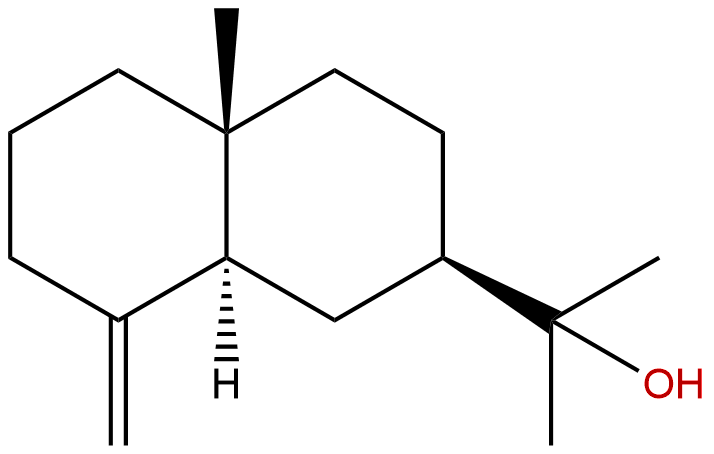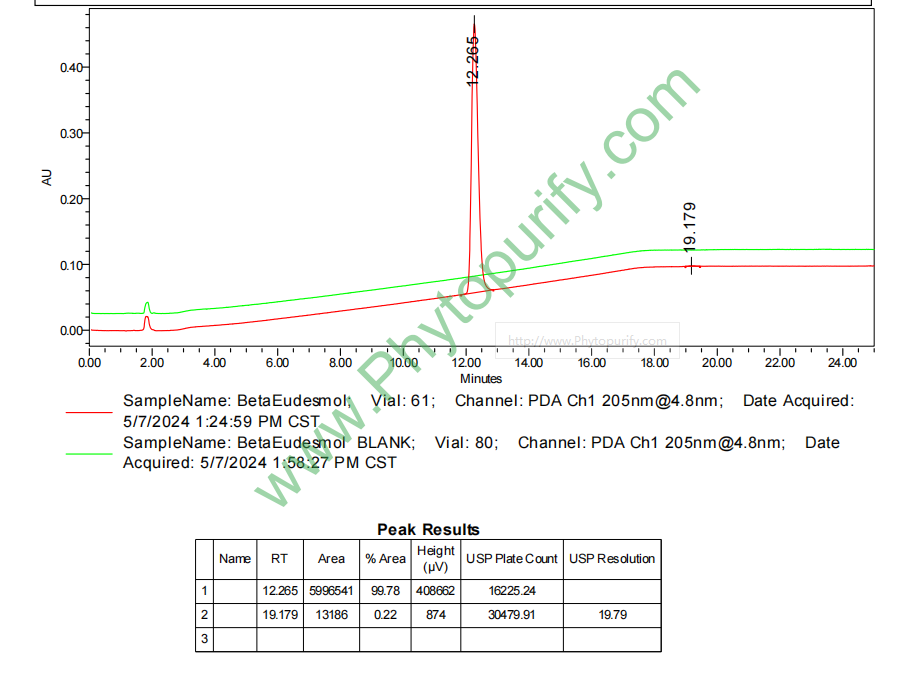
Beta-EudesmolCAS No.:473-15-4
|
||||||||||
 |
|
|
||||||||

| Catalogue No.: | BP0263 |
| Formula: | C15H26O |
| Mol Weight: | 222.372 |
Product name: Beta-Eudesmol
Synonym name: 4(15)-Selinen-11-ol
Catalogue No.: BP0263
Cas No.: 473-15-4
Formula: C15H26O
Mol Weight: 222.372
Botanical Source: eucalyptus oils. A widely distrib. essential oils, freq. not differentiated from α-Eudesmol
Physical Description: White cryst.
Type of Compound: Sesquiterpenoids
Purity: 95%~99%
Analysis Method: HPLC-DAD or/and HPLC-ELSD
Identification Method: Mass, NMR
Packing: Brown vial or HDPE plastic bottle
Storage: Store in a well closed container, protected from air and light. Put into refrigerate or freeze for long term storage.
Whenever possible, you should prepare and use solutions on the same day. However, if you need to make up stock solutions in advance, we recommend that you store the solution as aliquots in tightly sealed vials at -20℃. Generally, these will be useable for up to two weeks.
The product could be supplied from milligrams to grams, up to kilograms
Inquire for bulk scale.
Descriptions:
Beta-eudesmol, a sesquiterpenoid alcohol isolated from Atractylodes lancea rhizome, can inhibit angiogenesis, at least in part, through the blockade of the ERK signaling pathway, suggests that it may aid the development of drugs to treat angiogenic diseases.[1]
Beta-eudesmol induces neurite outgrowth in rat pheochromocytoma cells accompanied by an activation of mitogen-activated protein kinase, it may be a promising lead compound for potentiating neuronal function, and the drug may be useful in helping to clarify the mechanisms underlying neuronal differentiation.[2]
Beta-eudesmol has potential anti-angiogenic and anti-tumour activities, it inhibits angiogenesis by suppressing CREB activation in growth factor signalling pathway, is an inhibitor of tumour growth.[3]
Beta-eudesmol induces apoptosis is accompanied by cleavage of caspase-3, caspase-9, and poly (ADP-ribose) polymerase; downregulation of Bcl-2 expression; release of cytochrome c from mitochondria; and decrease in mitochondrial membrane potential (MMP), suggests it induces apoptosis in HL60 cells via the mitochondrial apoptotic pathway, which is controlled through JNK signaling. [4]
References:
[1] Tsuneki H, Ma E L, Kobayashi S, et al. Eur J Pharmacol, 2005, 512(2-3):105-15.
[2] Obara Y, Aoki T, Kusano M, et al. J Pharmacol Exp Ther, 2002, 301(3):803-11.
[3] Tsuneki H. J Asian Nat Prod Res, 2008, 10(1-2):159-167.
[4] Li, Yanchun, Li, et al. Phytother Res, 2012, 27(3):338-43.
[5] Chen Y M, Chou G X, Wang Z T. China journal of Chinese materia medica, 2007, 32(21):2265-7.
HPLC of Beta-Eudesmol
